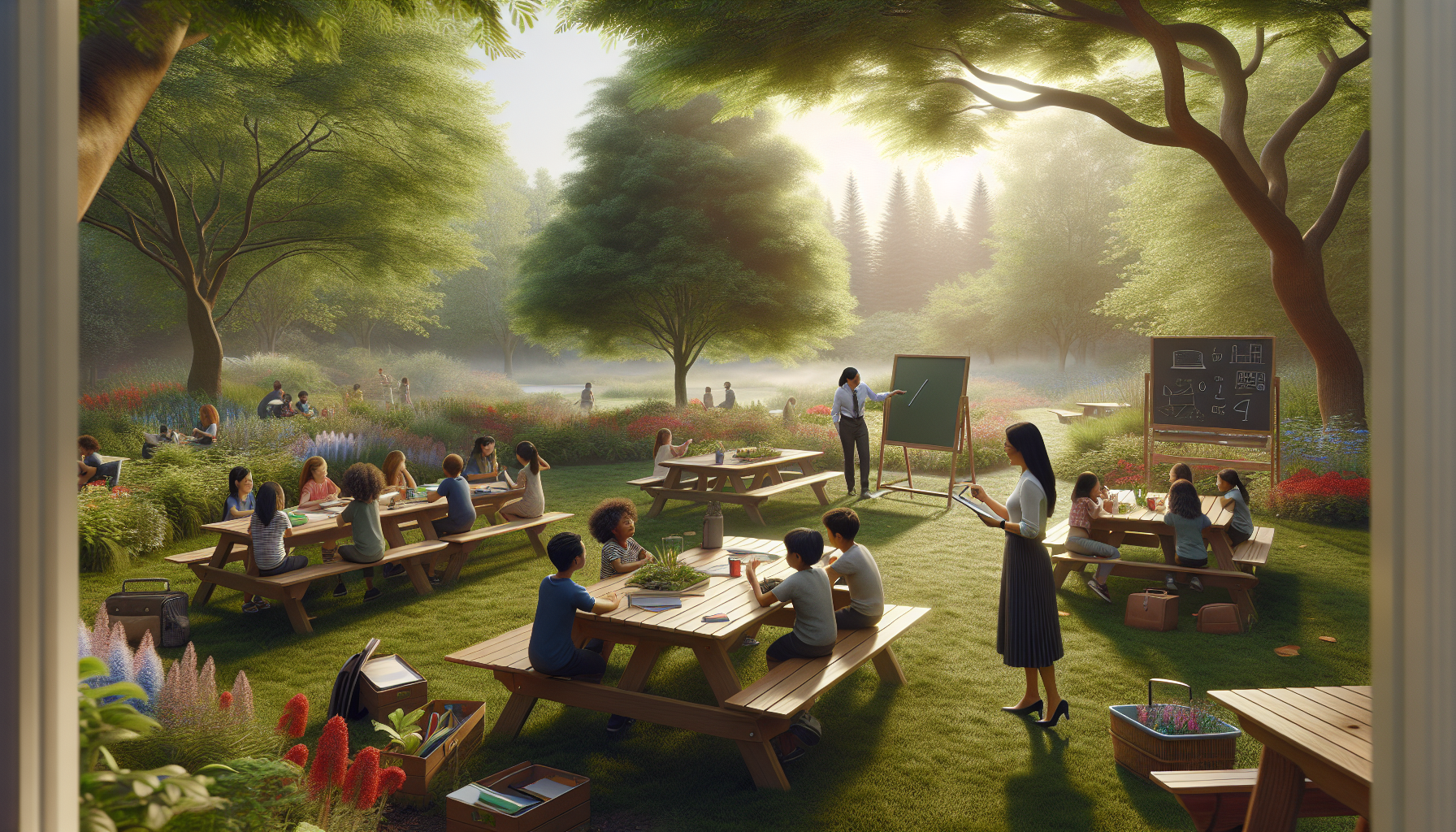In the rapidly evolving landscape of education, the traditional notion of a classroom—four walls, rows of desks, a blackboard—has begun to transform in ways that are as refreshing as they are innovative. As educators and students alike seek to break free from conventional boundaries, a new frontier in learning environments is emerging: the open-air classroom. Imagine stepping into a learning space where the whisper of the wind replaces the hum of fluorescent lights and where the blue sky serves as a limitless ceiling. This is not merely a flight of fancy; it’s an educational revolution that’s gaining momentum across the globe. 🌍
The allure of the great outdoors has always captivated the human spirit, and harnessing this fascination for educational purposes has led to a renaissance in how we perceive learning spaces. The concept of open-air classrooms is rooted in a simple yet profound idea: nature itself is a powerful teacher. Studies have consistently shown that exposure to natural environments can enhance cognitive function, reduce stress, and increase motivation—all crucial components of effective learning. This article delves into the transformative power of outdoor learning environments, exploring how they are redefining education for students of all ages.
As we embark on this journey, we’ll first explore the historical context of open-air classrooms and how their resurgence today is addressing modern educational challenges. From battling the constraints of limited indoor space to fostering a more inclusive and engaging learning experience, these outdoor settings offer solutions that traditional classrooms often struggle to provide. The integration of nature into education is not a new concept; however, the current global shift towards these environments is breathing new life into age-old practices, reminding us of the enduring benefits of learning amidst nature.
Moreover, we will examine the tangible benefits that open-air classrooms provide, supported by cutting-edge research and real-world examples. From improved concentration and creativity to fostering teamwork and social skills, the advantages of outdoor learning are numerous and impactful. This exploration will be complemented by insights from educators who have successfully implemented these environments, sharing their firsthand experiences and the positive changes they’ve observed in their students. 🍃
Finally, we’ll tackle the practicalities of converting traditional classrooms into vibrant outdoor spaces. This section will offer guidance on overcoming potential challenges, such as weather conditions and resource allocation, while highlighting innovative design strategies that maximize the use of natural surroundings. By the end of this article, you will not only understand the myriad benefits of open-air classrooms but also feel inspired to advocate for and participate in this educational evolution. So, let’s step outside, breathe in the fresh air, and embark on a journey that promises to reshape the way we think about learning. 🌿
The Rise of Open-Air Classrooms
The educational landscape is rapidly evolving, with innovative approaches to teaching and learning becoming increasingly mainstream. One such trend that has gained significant traction is the conversion of traditional classrooms into open-air learning environments. This transformation is driven by a combination of educational research, environmental awareness, and the ongoing search for engaging and effective learning methods. Open-air classrooms offer a host of benefits that are not only limited to the physical health of students but extend to their mental and emotional well-being as well.
The concept of open-air classrooms is not new. In fact, it has its roots in early 20th-century Europe, where outdoor learning was seen as a solution to improve public health and combat the spread of tuberculosis. Today, the motivations are different but equally pressing. Educators and policymakers are increasingly concerned with providing learning environments that enhance cognitive function, reduce stress, and improve attention spans. Studies have shown that exposure to natural environments can significantly improve these factors, making outdoor classrooms a compelling choice.
Moreover, the recent global pandemic has accelerated the interest in open-air learning spaces. With the need for social distancing and improved ventilation, outdoor classrooms provide a practical solution for safe, face-to-face instruction. Schools are now considering permanent outdoor spaces that can be used year-round, with adaptations to weather conditions and the incorporation of technology to enhance the learning experience.
Benefits of Open-Air Learning Environments
- Improved Physical Health: Outdoor environments promote physical activity, which is crucial for children’s health. It encourages movement, reducing sedentary behavior, and can help address issues like obesity and related health concerns.
- Enhanced Mental Health: Nature exposure is linked to reduced stress levels and improved mood. It can also lower anxiety and depression symptoms, contributing to a more positive learning experience.
- Increased Engagement and Motivation: Learning in a natural setting can make lessons more engaging and memorable. The novelty of being outdoors can spark curiosity and enhance motivation, leading to better academic outcomes.
In addition to these benefits, open-air classrooms encourage creativity and collaboration. The flexible and often less formal setting allows students to interact more freely, fostering communication and teamwork skills. Teachers also report that students are more attentive and focused in outdoor settings, which can lead to improved learning outcomes.
Designing Effective Open-Air Classrooms
Creating a successful open-air classroom requires careful planning and consideration. Schools must address various logistical and environmental factors to ensure these spaces are both functional and conducive to learning. Here are key elements to consider when designing an outdoor classroom:
- Location and Layout: The chosen site should be easily accessible and safe for students. It should also offer a balance of sun and shade, with enough space for seating and activities. Layouts can vary, from amphitheater-style seating to modular arrangements that can be adapted for different subjects and group sizes.
- Materials and Resources: Durable, weather-resistant materials are essential for outdoor furniture and equipment. Considerations should also be made for technology integration, such as outdoor Wi-Fi and power sources for devices.
- Adaptability: Open-air classrooms should be versatile enough to accommodate various subjects and teaching styles. They should include features like writable surfaces, storage for materials, and spaces for group work and individual study.
The success of an open-air classroom also depends on the ability to adapt to different weather conditions. Schools might consider adding shelters or portable structures that provide protection from rain and wind while maintaining the benefits of being outdoors. Additionally, incorporating natural elements like gardens or water features can enhance the learning environment, making it more inviting and interactive.
Table of Open-Air Classroom Design Elements
| Element | Description | Considerations |
|---|---|---|
| Location | Accessible, safe, balanced sun/shade | Proximity to school buildings, noise levels |
| Materials | Weather-resistant, durable | Comfort, maintenance requirements |
| Technology | Outdoor Wi-Fi, power sources | Security, connectivity |
| Adaptability | Flexible layouts, multipurpose | Ease of reconfiguration, storage solutions |
Case Studies and Real-World Examples
To better understand the practical application of open-air classrooms, we can look at several schools that have successfully implemented these spaces. Each case study provides insights into different approaches and the resulting benefits for students and educators alike.
Green School, Bali: This renowned institution takes sustainability and environmental education to new heights with its extensive use of open-air classrooms. The school’s bamboo structures blend seamlessly with the natural environment, creating a learning space that emphasizes ecological awareness and hands-on learning. Students here engage in a curriculum that is deeply intertwined with the natural world, fostering a profound understanding of sustainability.
Punahou School, Hawaii: Punahou School has incorporated outdoor classrooms as part of its commitment to innovative education. The school uses its lush campus to provide diverse learning experiences, from science experiments in their botanical gardens to history lessons under ancient trees. These settings encourage students to connect with their surroundings and think critically about the role of the environment in their studies.
These examples demonstrate the diverse possibilities of open-air classrooms, showcasing their ability to transform education by bringing students closer to nature and enhancing their overall learning experience.
Watch a Related Video on YouTube
For a visual exploration of open-air classrooms, check out this inspiring video: Transforming Outdoor Learning Spaces from the “Education Innovators” channel. It offers a comprehensive overview of the benefits and implementation strategies of outdoor learning environments. 🌿

Conclusion
Conclusion: Transforming Education Through Open-Air Classrooms
In our exploration of transforming learning through open-air classroom conversions, we’ve traversed the multifaceted benefits and challenges of this innovative educational approach. From enhancing student engagement to promoting environmental stewardship, the open-air classroom is not merely an educational trend but a powerful pedagogical transformation that has the potential to redefine how education is delivered and experienced.
### Recapitulation of Key Points
Throughout this article, we have highlighted the significant impact that open-air classrooms can have on both students and educators. First and foremost, the natural environment serves as a dynamic educational tool. Research consistently shows that exposure to nature enhances cognitive function, reduces stress, and boosts mood, which collectively contribute to improved academic performance (Louv, 2008). In open-air settings, students often demonstrate heightened creativity and critical thinking, key skills necessary for navigating the complexities of the modern world.
Moreover, open-air classrooms encourage active learning and foster a sense of community. The physical layout and atmosphere of outdoor settings break down traditional hierarchical structures often present in indoor classrooms, thereby promoting collaborative learning. This inclusive environment allows students to engage more freely and confidently with both their peers and teachers, leading to deeper understanding and retention of material.
Environmental education is another crucial component that open-air classrooms naturally incorporate. By learning amidst the elements, students develop a profound appreciation for the natural world and a sense of responsibility towards its preservation. This hands-on experience with the environment can inspire future generations to advocate for sustainable practices and policies, addressing the pressing issues of climate change and environmental degradation.
### Addressing Challenges
Despite the numerous benefits, transitioning to an open-air learning model presents logistical challenges that must be addressed. Weather conditions, accessibility, and resource availability are significant considerations that schools must navigate. However, these challenges are not insurmountable. With innovative design solutions, such as modular canopies and portable heating systems, along with strategic scheduling, schools can effectively mitigate these barriers (Source: Outdoor Classroom Design Guide, 2023).
### The Importance of Open-Air Classrooms
The importance of embracing open-air classrooms extends beyond educational outcomes; it represents a shift towards more sustainable and holistic community values. By integrating nature into daily learning, schools can cultivate an educational culture that prioritizes well-being, environmental consciousness, and resilience. This model aligns with broader societal goals of fostering healthier, more connected communities.
### Inspiring Action and Engagement
We encourage educators, policymakers, and community leaders to consider the potential of open-air classrooms in their local contexts. Start small, perhaps by integrating outdoor learning days or creating garden spaces that facilitate educational activities. Communities can come together to support schools in this transition, whether through volunteering, fundraising, or simply advocating for policies that support outdoor education initiatives.
As we conclude, we invite you, our readers, to share your thoughts and experiences. Have you witnessed the transformative power of open-air classrooms? What challenges or successes have you encountered? Your insights are invaluable in shaping the future of education, so please comment below or share this article with others who might find it enlightening. By spreading awareness and fostering dialogue, we can collectively drive change and inspire a new era of learning that values both academic excellence and environmental stewardship 🌿.
In embracing the potential of open-air classrooms, we are not only enhancing educational experiences but also contributing to a more sustainable and interconnected world. Together, let us champion this movement and pave the way for a brighter, greener future.
—
For further reading and resources, consider exploring:
– Louv, R. (2008). Last Child in the Woods: Saving Our Children from Nature-Deficit Disorder.
– Outdoor Classroom Design Guide, 2023 (Ensure the link leads to an active source with relevant content)
Thank you for joining us on this journey of discovery and innovation in education. 🌟
Toni Santos is a visual storyteller and educational ethnographer whose work celebrates the fluid knowledge systems of nomadic cultures. Through art and research, Toni brings attention to how learning has thrived outside traditional institutions—rooted in movement, oral tradition, and deep connection to land and community.
Guided by a passion for ancestral wisdom, adaptive pedagogy, and cultural resilience, Toni explores the tools, rituals, and environments that once shaped the minds of travelers, herders, and migrating communities. Whether illustrating storytelling circles beneath open skies, wearable mnemonic devices, or maps woven into textiles, Toni’s work honors learning as a lived, sensory, and communal experience.
With a background in visual anthropology and intercultural design, Toni reconstructs the educational models of mobile societies through images and narratives that restore their dignity and relevance in today’s world.
As the creative mind behind Vizovex, Toni shares a rich tapestry of visual essays, artifact-inspired art, and curated stories that reveal the genius of teaching and learning on the move.
His work is a tribute to:
The wisdom of learning through journey, rhythm, and story
The spatial and environmental intelligence of nomadic cultures
The power of intergenerational knowledge passed outside walls
Whether you’re an educator, researcher, or lifelong learner, Toni invites you to step into a world where education is not confined, but carried—one step, one song, one shared insight at a time.





